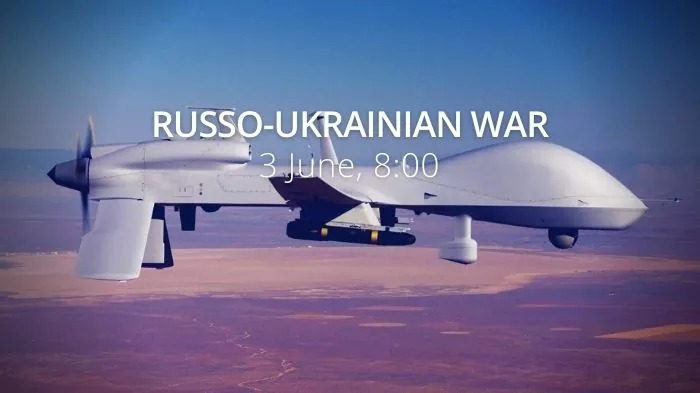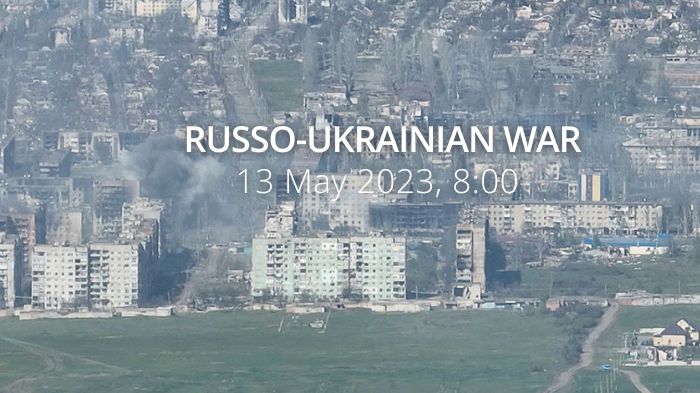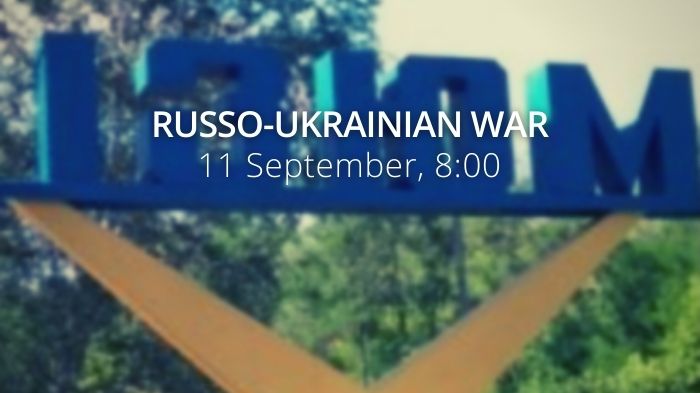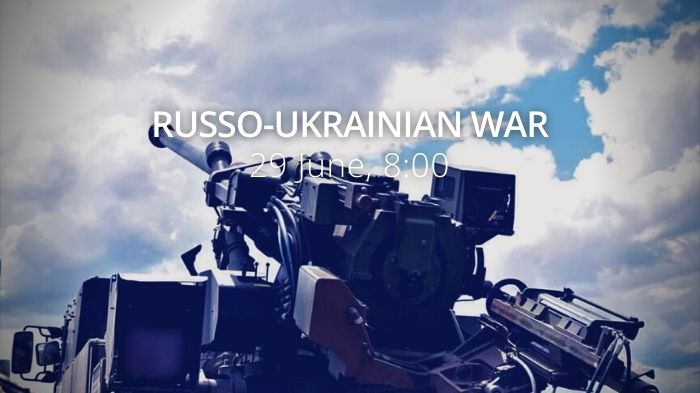Morning report day 100 – June 03: Situation
Fighting continues in Sievierodonetsk, Russian forces conduct assaults in the direction of Lyman, but Ukrainian forces pushed back Russian assault operations in the direction of Sloviansk, Sievierodonetsk, Kryvyi Rih, and near Krasnohorivka and Poltavka.
According to information from the General Staff as of 06.00 03.06.2022, supplemented by its [18:00 assessment].
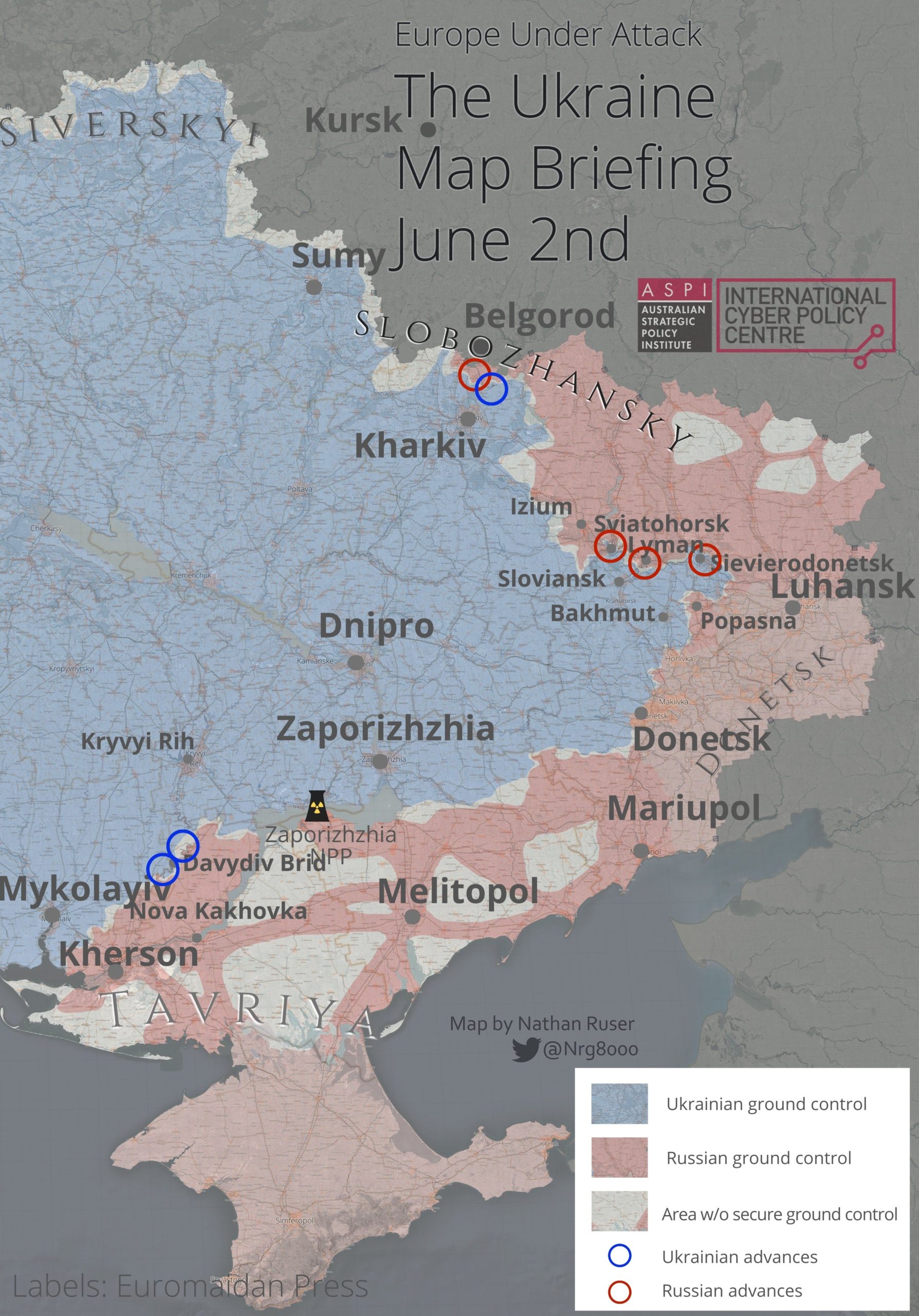
- [Forest roads, bypasses and bridges are being mined in the border areas with our country.]
Russian forces did not take active action in the Siversky direction. It fired a missile at civilian infrastructure in the Hudovo district of Sumy oblast. Also in the Sumy region, the enemy fired on the areas of Bachivsk, Khodyne and Slavgorod.
- [There is a movement of artillery and motorized infantry units that were in the areas of recovery.]
In the Slobozhansky direction, Russian forces continue to prepare for the offensive. It replenishes stocks of material resources, weapons and equipment from the territory of the Russian Federation. In order to reduce the offensive potential of our troops, it fires from artillery and multiple rocket launchers.
- Russian forces did not take any active action in the Kharkiv direction. The main efforts are focused on deterring the actions of the Defense Forces of Ukraine. Russian forces fired on civilian infrastructure in the areas of Bashkirovka, Mospino, Ruska Lozova, Pechenigy and Mykhailivka. It inflicted air strikes near Nove. [Yesterday, Russian forces shelled civilian infrastructure in the areas of the settlements of Tsyrkuny, Stara Hnylytsia, Peremoha and Staryi Saltiv. It inflicted airstrikes near Nove.]
- In the Sloviansk direction, Russian forces are concentrating in particular on the engineering equipment of the positions. The shelling of civilian infrastructure was recorded in the districts of Dibrivny, Kurulka, Vernopillya, Chervona Polyana and others. Near Dovhenke, Russian forces launched airstrikes with army aircraft. It carried out assault operations in the areas of the settlements of Bohorodychne and Dolyna, was unsuccessful, and withdrew after losses inflicted by units of the Defense Forces. [Yesterday, it fired on civilian infrastructure in the areas of Dovhenke, Virnopillya, Hrushuvakha, Velyka Komyshuvakha and Husarivka.]
In the Donetsk direction, Russian occupiers continue artillery fire along the entire line of contact.
- In the Lyman direction, Russian forces fired on civilian infrastructure in the areas of the settlements of Yarova, Shchurove, Staryi Karavan and Raihorodok. It carried out assaults near Studenka, and the fighting continues. In this direction, Russian forces intensified the work of electronic warfare.]
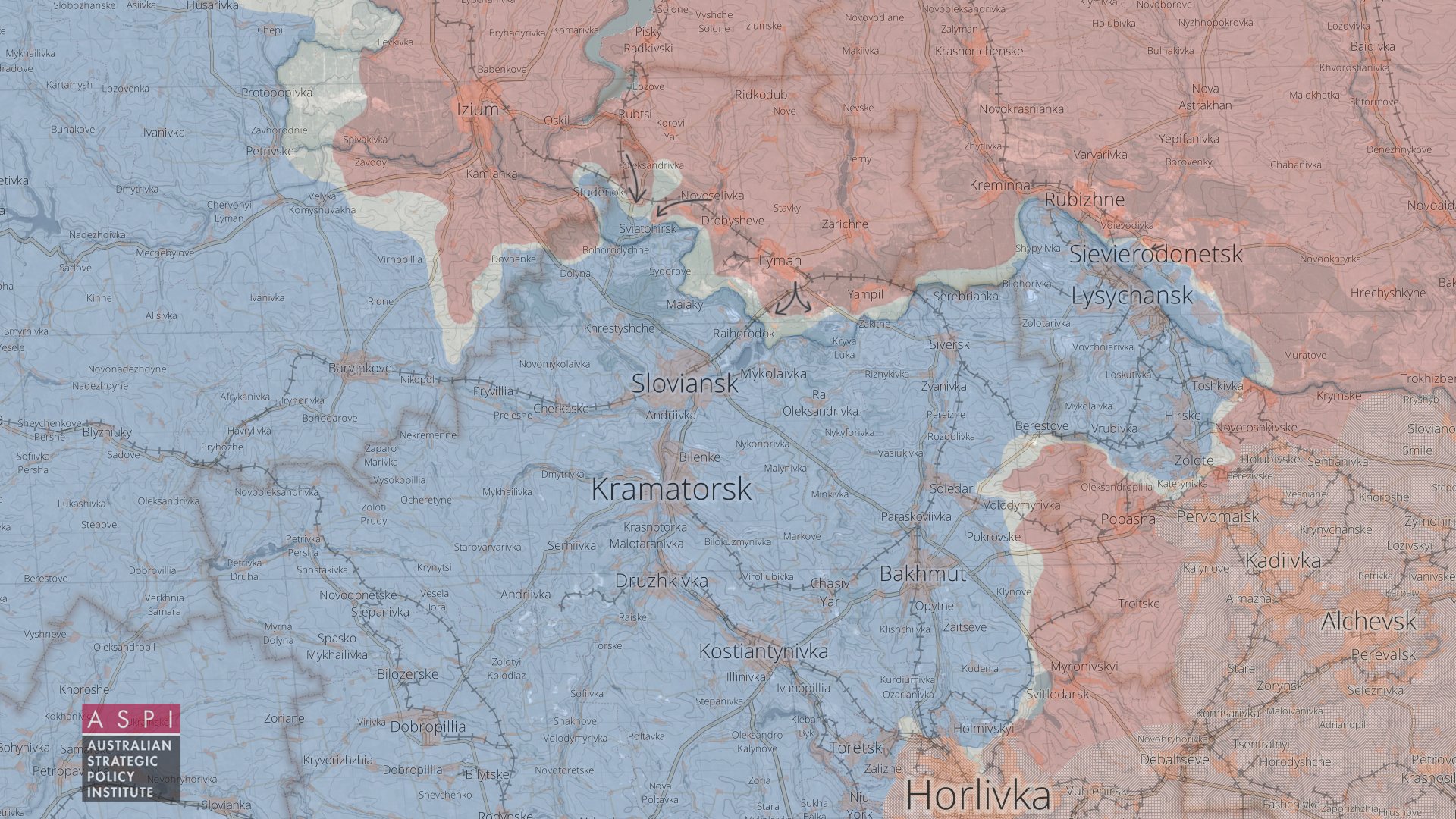
- In the Sievierodonetsk direction, Russian invaders continue to shell the positions of the Defense Forces and civilian infrastructure in the areas of the settlements of Sievierodonetsk, Borivske, Ustynivka and Lysychansk. Russian assault aircraft launched air strikes near the Myrna Dolyna. In addition, in the area of Mietolkino and Bilohorivka, the enemy tried to carry out assault operations, suffered losses, and retreated to previous positions. Fighting continues in the central part of Sievierodonetsk. [Yesterday, enemy assault aircraft struck in the areas of Ustynivka and Borivske. Russian forces carried out assaults near Borivske, but had no success.]
- In the Bakhmut direction, Russian forces fires in the areas of Pokrovske, Niu York, Zolote, Komyshuvakha, Mykolayivka, Berestove, Bilohorivka and Vrubivka. Near the latter, the occupiers conducted unsuccessful assault operations. With the assault forces and army aircraft, Russian forces launched airstrikes on infrastructure near Vidrodzhennia, Rotiv, Novoluhansk, and Dolomtne.
- Russian forces did not conduct active hostilities in the Avdiivka, Kurakhiv, Novopavliv and Zaporizhzhia directions. It fired on civilian infrastructure in the areas of Kamyanka, Vesele, Mariinka, Novomykhailivka, Avdiivka, Pisky, and Zolota Nyva. It tried to engage in clashes and assault operations near Krasnohorivka and Poltavka with the help of separate units and sabotage and reconnaissance groups. It was unsuccessful, retreated to previous positions.
[In the Pivdennyy Buh direction, to maintain the established frontline, Russian occupiers are destroying the transport infrastructure in the probable directions of the Defense Forces.]
- During the day, Russian forces used mortars, artillery and rocket-propelled grenade launchers on civilian infrastructure in the areas of the settlements of Kavkaz, Lepetykha, Dmytrivka, Osokorivka, Blahodiyne, and Stepova Dolyna. In some areas of the Kryvyi Rih direction, Russian forces intensified air reconnaissance and attempted assault operations. It was repulsed and retreated to his former position. [Russian forces are forced to defend an unprepared frontier. It intensified the work of electronic warfare. Yesterday, it inflicted fire damage on civilian infrastructure in the areas of Shyroke, Lepetykha, Shevchenkove, Osokorivka, Partyzanske and others.]
- In order to maintain the frontline, Russian occupiers are strengthening their advanced positions by moving reserves to probable areas of deployment of units of the Defense Forces.
[In the Black Sea and the Sea of Azov, the Black Sea Fleet is focused on maintaining a favourable operational regime and blocking civilian shipping in the northwestern Black Sea.]
Over the past day, five enemy attacks were repulsed in the Donetsk and Luhansk directions, and five tanks, three artillery systems, and two armoured combat vehicles were destroyed. Air defence units shot down three Orlan-10 UAVs. In other areas, Russian occupiers also suffered significant losses.
Some units of the 150th Motorized Rifle Division of the 8th Combined Arms Army in the Popasna direction suffered significant losses, at least 50% of the personnel, weapons and equipment.
The personnel of Russian forces is demoralized, which is due to the constant postponement of their rotation. This leads to the refusal of personnel to participate in hostilities.
[Russian forces continue to suffer losses in manpower and equipment. Thus, according to available information, 115 wounded and 32 dead people were admitted to medical institutions only in the temporarily occupied territories of the Donetsk region in the period from May 27 to 28, 2022.]
[Due to heavy sanitary and irreversible losses in the military units and units of the 1st Army Corps of the 8th Combined Arms Army of the Armed Forces of the Russian Federation, forced mobilization measures are underway in the temporarily occupied territories of Donetsk oblast.]”
Ukrainians battle Russian forces in the heart of the key eastern city of Sievierodonetsk, The New York Times
reports. “Ukrainian troops pushed Russian soldiers back several blocks in street battles in the city of Sievierodonetsk, a regional official said Thursday, indicating that fighting continued even as Russia renewed its effort to surround Ukrainian soldiers in the city. The Russian forces, however, have renewed assaults to the west of the city in an effort to sever the supply line along a highway and side roads that Ukrainians have called the “road of life,” the Institute for the Study of War said in an assessment.
Military analysts have viewed the Ukrainian army’s decision to hold out in the city as a risky manoeuvre that on the one hand allows the Ukrainians to inflict casualties on Russian troops in urban combat and on the other risks an encirclement.”
General Staff of the Armed Forces of Ukraine has calculated how many missiles Russia has fired at Ukraine so far, Ukrainska Pravda reports. "Since the beginning of hostilities, Russian occupying forces have carried out 5,722 operational-tactical flights and launched 551 "Iskander" and "Kalibr" cruise missiles, Oleksii Hromov, the Deputy Chief of the Main Operations Department of the Ukrainian General Staff said according to "Interfax-Ukraine.
Of these, more than 20% (1,211 flights) were made from the territory of the Republic of Belarus alone. 61 "Iskander" cruise missiles were launched against critical infrastructure in Ukraine.
The United States estimates that up to 60% of the precision-guided missiles Russia is using against Ukraine are not reaching their targets. The abovementioned missiles do not include all missiles launched against Ukraine (e.g. airstrikes or other land-launched missiles)
Russian troops launched a massive missile strike on the Mykolayiv region, Ukrinform reports. “A massive missile strike with the use of strategic aviation was launched on Mykolayiv region. The enemy hit the previously destroyed railway bridge near the village of Trykhaty with four cruise missiles,” the Operational Command South posted on Facebook. Moreover, the Black Sea coast of the Mykolayiv region and the rear areas of positions of the Armed Forces of Ukraine were attacked.”
According to British Defence Intelligence, (last 24 hours):
- Russian forces failed to achieve their initial objectives to seize Kyiv and Ukrainian centres of government. Staunch Ukrainian resistance and the failure to secure Hostomel airfield in the first 24 hours led to Russian offensive operations being repulsed. Following the failure of the initial plan, through false planning assumptions and poor tactical execution, Russia adapted its operational design to focus on the Donbas.
- Russia is now achieving tactical success in the Donbas. Russian forces have generated and maintained momentum and currently appear to hold the initiative over Ukrainian opposition. Russia controls over 90% of Luhansk Oblast and is likely to complete control in the next two weeks. Russia has achieved these recent tactical successes at significant resource cost, and by concentrating force and fires on a single part of the overall campaign. Russia has not been able to generate manoeuvre or movement on other fronts or axes, all of which have transitioned to the defensive.
- Measured against Russia’s original plan, none of the strategic objectives have been achieved. In order for Russia to achieve any form of success will require continued huge investment of manpower and equipment and is likely to take considerable further time.
As of Friday 3 June, the approximate losses of weapons and military equipment of the Russian Armed Forces from the beginning of the war to the present day:
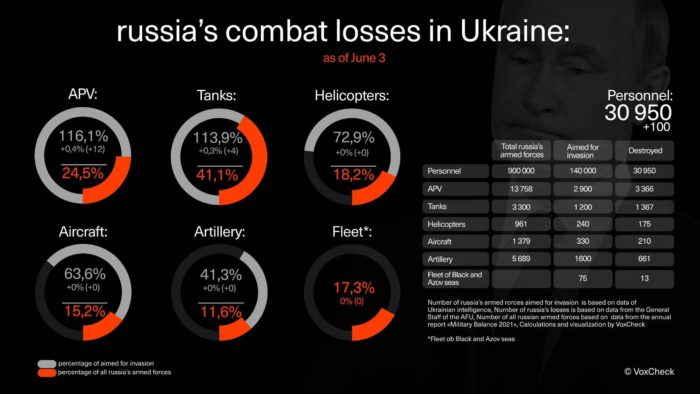
- Personnel – more than 30950 (+100),
- Tanks – 1367 (+4),
- Armoured combat vehicles – 3366 (+12),
- Artillery systems – 675 (+14),
- Multiple rocket launchers –MLRS - 207 (+0),
- Air defence means – 95 (+1),
- Aircraft - 210 (+0),
- Helicopters - 175 (+0),
- Automotive technology and fuel tanks – 2329 (+4),
- Vessels/boats - 13 (+0),
- UAV operational and tactical level – 535 (+14),
- Special equipment – 51 (+0),
- Mobile SRBM system – 4 (+0),
- Cruise missiles – 121 (+1),
Russian enemy suffered the greatest losses (of the last day) in the Bakhmut direction.
Zelenskyy tells EU leaders real losses of Armed Forces of Ukraine in Donbas, Ukrainska Pravda reports. President Zelenskyy has said that about 100 servicemen of the Armed Forces of Ukraine are killed and up to 450-500 are wounded in Donbas every day.
Humanitarian
According to UNHCR 6,938,041 refugees have been registered as of June 1. The UN says that so far Poland has taken in (border crossings) 3,690,089 refugees, Russian Federation 1,041,095, Hungary 698,420, Romania 587,219, Republic of Moldova 483,306, Slovakia 466,264 and Belarus 16,648. Among those who fled Ukraine are also Ukrainian nationals with dual citizenship. An additional 105,000 people moved to the Russian Federation from the Donetsk and Luhansk regions between 18 and 23 February.
The number of Ukrainians entering Ukraine since February 28 is 2,388,941 as of June 1. This figure reflects cross-border movements, which can be pendular, and does not necessarily indicate sustainable returns.
OHCHR recorded 9,151 civilian casualties in Ukraine as of June 1. 4,169 were killed (including 268 children) and 4,982 injured (including 423 children).
Environmental
Zelenskyy predicts mass protests in Europe if Ukrainian ports are not unblocked, Ukrainska Pravda reports. In his speech at Bratislava Global Security Forum, President Zelenskyy said "It is impossible to avoid the blockade of Ukrainian ports by the Russian Federation. Because of this act of aggression by the Russian state, the world is on the brink of a food crisis. And it's not just a food problem. It is a shortage in the market, it is a catastrophic rise in prices for basic products, and it is the threat of hunger for tens of millions of people.
If this is not prevented, we will face the problem of political chaos in some countries in Africa and Asia and consequently, a migration crisis in Europe, when people from countries suffering from hunger will seek salvation. Also, the food crisis will inevitably lead to large-scale protests in European countries. Many governments will have to explain to protesters why our continent has been taken hostage by one state - Russia - and one person in Moscow - who ordered a naval blockade of Ukraine."
Ukraine is considering a scenario involving a complete shutdown of the occupied Zaporizhzhia Nuclear Power Plant, Ukrainska Pravda reports. In early March, Russian forces captured the town of Enerhodar and ZNPP, located near the town. It is the largest nuclear power plant in Europe and the third-largest in the world. Ukraine is not ruling out a scenario that in the event Russia risk losing control of the region it will completely shut down the Zaporizhzhia Nuclear Power Plant. This was stated by Yurii Boiko, the Adviser to the Prime Minister, in a comment on Energy reform.
"In preparation for the sustainable heating season, a scenario with a complete shutdown of the Zaporizhzhia Nuclear Power Plant is being considered," Boiko added. Also, he said that Ukraine's energy system is ready and able to cope with the consequences of such a decision.”
Energoatom, however, responded to the assessment above and stated that "its shutdown is impossible from technical, security, economic and political perspectives", Ukrainska Pravda reports.
“Energoatom representatives have added that the Zaporizhzhia NPP has operated, is operating and will continue to consistently operate in the Ukrainian energy system. "We have every reason to say this with confidence," Energoatom representatives have summed up.”
Legal
Over 30 towns in Donbas were exposed to Russian shelling yesterday, Ukrainska Pravda reports. "The occupiers have shelled nearly 30 towns and villages in Donetsk and Luhansk oblasts and have destroyed or damaged 52 civilian objects, including 42 residential buildings, two factories, administrative premises and equipment of several rescue and fire service stations, and a hangar. Five civilians were killed in the shelling, and seven others were wounded”, according to Joint Forces Task Force and Operational Command East.
Ukraine at OSCE talks about the abduction of children by Russians, Ukrinform
reports. “Since February 2022 alone, 243 children have been killed due to Russian aggression, 446 have been injured, and thousands have suffered psychological trauma and are constantly under threat. "In addition, some of them are still in danger even after the end of hostilities. At least 230,000 Ukrainian children have been deported to Russia. And how cynical is to sign a decree that expedites granting Russian citizenship to Ukrainian orphans or those left without parental care on the eve of International Children's Day. In fact, the Russian president legalized the abduction of Ukrainian children, [Head of Ukraine’s mission to OSCE Yevhenii] Tsymbaliuk said.
It is a gross violation of the 1949 Geneva Convention relative to the Protection of Civilian Persons in Time of War, the 1989 UN Convention on the Rights of the Child, and the Convention on the Prevention and Punishment of the Crime of Genocide, the diplomat stressed. "But this is what is called Russia's state policy. First, they come to kill their parents, and then they take children away," said the head of Ukraine's mission to OSCE.”
 261 children were killed, and 463 children injured, the Office of the Prosecutor General of Ukraine reports as of June 3. 1,938 educational establishments are damaged as a result of shelling and bombings, and 182 of them are destroyed fully. 15,446 crimes of aggression and war crimes and 7,232 crimes against national security were registered.
261 children were killed, and 463 children injured, the Office of the Prosecutor General of Ukraine reports as of June 3. 1,938 educational establishments are damaged as a result of shelling and bombings, and 182 of them are destroyed fully. 15,446 crimes of aggression and war crimes and 7,232 crimes against national security were registered.
https://twitter.com/EuromaidanPress/status/1532431335297585155
Support
F-16s Not on the Table for Ukraine, Says NATO Ambassador, Air Force Magazine reports. “The United States does not intend to provide high-end aircraft to Ukraine despite Russia’s advances in eastern Ukraine, US Permanent Representative to NATO Ambassador Julianne Smith said. While Smith said she relies on the Defense Department for detailed, regular talks with the Ukrainian Defense Ministry about Ukraine’s battlefield needs, she affirmed that the prospect of a prolonged conflict between Russia and Ukraine has not changed partners’ willingness to provide aircraft to Ukraine.
An eastern flank NATO official told Air Force Magazine that alliance members had not “directly” talked about providing American aircraft to Ukraine. The official said even the discussion of transferring Soviet-era fighters like the MiG-29s used by the Ukrainian Air Force is all but dead.”
Each US assistance package for Ukraine will be adjusted based on the battlefield situation, Ukrinform reports. “The United States will adjust each package of security assistance to Ukraine, taking into account the situation on the battlefield. US Ambassador to Ukraine Bridget Brink told this to journalists in Kyiv on Thursday.
A drawdown of $700 million in security assistance is not going to be the last, because it is part of the $40 billion assistance package that has been approved by Congress and signed by the President. So each package is going to be adjusted based on the battlefield situation and our conversations with Ukrainians as to what they need, she said.
She noted that the United States is actively coordinating international military assistance to Ukraine with Ukrainian partners. We all believe that this assistance needs to happen quickly. I do think that there were some problems at first but my understanding is that now it's very quick, within days, less even, of a decision, that the hardware is in Ukrainian hands, the ambassador said.”
US ambassador names five main areas of work in Ukraine, Ukrinform reports. “US Ambassador to Ukraine Bridget Brink has named five main areas of the embassy's work in Ukraine. According to Brink, the first area of work is to help Ukraine win its war against Russian aggression. As President Biden said yesterday, 'Standing by Ukraine in its hour of need is not just the right thing to do. It is in our vital national interests to ensure a peaceful and stable Europe and to make it clear that might does not make right', the ambassador said.
Secondly, the US embassy will work to ensure that US humanitarian assistance gets to those who need it. Thirdly, the embassy will work to ensure the world holds Russia to account for war crimes and atrocities. The fourth area of work, Brink said, will be to oversee the implementation of US security assistance to ensure that this assistance achieves its goal. The fifth area will be "rebuilding the embassy platform and bringing our team back together. Our unwavering position in all of these goals is that Ukraine should decide its own future. Period. And at the right moment we will help Ukraine rebuild, the diplomat said.”
Sweden to send anti-ship missiles to Ukraine, Ukrinform reports. "Sweden will send anti-ship missiles, anti-tank weapons and 12.7 mm rifles including ammunition to Ukraine. This 4th support package also includes a financial contribution to the Ukrainian Armed Forces. The total amount includes more than 95 million euros, the [Swedish Foreign Minister Ann Linde announced on Twitter].”
Ukraine may receive USD 4.8B from international partners in June, Ukrinform reports. "Indeed, the amount of aid we receive is less than the estimated need of USD 5 billion a month. We believe that foreign aid will increase in the near future. According to reports, the Ministry of Finance expects to receive USD 4.8 billion from international partners in June, [Deputy Governor of Ukraine’s National Bank Yuriy] Heletiy, said.”
The US adds Russian airplane factories to economic blacklist, Reuters reports. “The United States on Thursday added 71 Russian and Belarusian entities to its trade blacklist including several aircraft factories and shipbuilding and research institutes in its latest effort to deprive the Russian military of US technology and other items. The export restrictions are among a raft of new sanctions the Washington imposed on Thursday in response to Russia's war in Ukraine, including prohibitions on additional Russian oligarchs and members of the country's elite.”
New developments
- Türkiye stated it may become possible to export Ukrainian grain, Ukrainska Pravda reports, citing Anadolu Agency. “The media reports that a roadmap addressing the global food crisis has been prepared under the auspices of the UN. The details of this roadmap will be discussed in the coming days at a meeting with representatives of Russia, Ukraine, Türkiye and the UN. Issues such as the route, insurance, and security of the ships and especially the clearing of sea mines in the region will be evaluated at the quadripartite meeting, the media informs.”
- Shmyhal calls on the UN to take decisive action to avoid a global food crisis, Ukrinform reports. In an interview with The Wall Street Journal, “Ukrainian Prime Minister Denys Shmyhal has accused Russia of orchestrating a global food crisis, denounced its blockade of Ukrainian ports and called on the UN and international partners to take decisive action to respond to these challenges”.
- Russia waging a war of annihilation so it’s important to keep helping Ukraine - German FM, Ukrinform reports. "Russia must not win this war. It must lose strategically as it commits violations not only as regards Ukraine, but also violates international law. They want to destroy the peace in Ukraine. That's why Ukraine must not lose under any circumstances – that means Ukraine must win," Baerbock said at the Markus Lanz talk show on ZDF. The German Foreign Minister stressed that Russia is waging a war to destroy Ukraine, and therefore it is very important to continue assisting Ukraine.
- Russia won't close Tsar Peter's 'window to Europe', Kremlin says, Reuters reports. “The Kremlin said on Thursday that Russia did not plan to close "the window" to Europe which Tsar Peter the Great sought to open 300 years ago even though the West has imposed the most onerous sanctions in recent history over Russia's invasion of Ukraine. Russia's Feb. 24 invasion has killed thousands, displaced 13 million and raised fears of a broader conflict between the United States and Russia, by far the world's biggest nuclear powers. President Vladimir Putin says the West wants to destroy Russia, that the economic sanctions are akin to a declaration of economic war and that now Russia will turn towards building ties with other powers in Asia and the Middle East”.
- Western media openly call to null Russia’s state sovereignty, top security official [claims], TASS reports. "One of the most important tasks is to work out measures aimed to protect the national security in the media sphere, including under conditions when the Western countries had collectively unfolded a cynical media campaign to discredit our country, its history, traditions; voicing direct calls for the elimination of the [Russian] state sovereignty and humiliation of Russian people," [Secretary of Russia’s Security Council Nikolay Patrushev said on Thursday] said. [ME: EUvsDisinfo is the flagship project of the European External Action Service’s East StratCom Task Force. It was established in 2015 to better forecast, address, and respond to the Russian Federation’s ongoing disinformation campaigns affecting the European Union, its Member States, and countries in the shared neighbourhood. As of 3 June, it has debunked 13914 Russian attempts of disinformation. This statement added another one to the database.]
- OPEC Plus agrees to a bigger increase in oil supply. But prices keep rising, The New York Times reports. “The group of oil-producing nations known as OPEC Plus agreed on Thursday to a larger increase in supply than planned for July and August. The White House hailed the higher output as a diplomatic breakthrough after months of lobbying Middle East oil giants to raise production to ease price pressures.”
Assessment
1. On the War
The Institute for the Study of War has made the following assessment as of Thursday 2 June:
“Russian forces continued to make incremental, grinding, and costly progress in eastern Ukraine on June 2. Russian troops continued operations to capture Sievierodonetsk and further operations to capture Lysychansk. Russian military leadership will likely use the capture of these two cities to claim they have “liberated” all of Luhansk Oblast before turning to Donetsk Oblast but Russian forces are unlikely to have the forces necessary to take substantial territory in Donetsk Oblast after suffering further losses around Sievierodonetsk. Russian forces are evidently limited by terrain in the Donbas and will continue to face challenges crossing the Siverskyi Donets River to complete the encirclement of Sievierodonetsk-Lysychansk and make further advances westward of Lyman towards Sloviansk via Raihorodok. Russian military leadership continues to experience complications with sufficient force generation and maintaining the morale of mobilized personnel. The Ukrainian General Staff reported that the Donetsk People’s Republic’s (DNR) 1st Army Corps, under Russia’s 8th Combined Arms Army, is conducting forced mobilization in occupied areas of Donetsk Oblast. Russian forced mobilization is highly unlikely to generate meaningful combat power and will exacerbate low morale and poor discipline in Russian and proxy units. The 113th Regiment of the DNR posted a video appeal to Russian President Vladimir Putin on June 2 wherein forcibly-mobilized soldiers complain they have spent the entire war on the frontline in Kherson without food or medicine, and that mobilization committees did not conduct requisite medical screenings and admitted individuals whose medical conditions should have disqualified them from service. Ukraine’s Main Intelligence Directorate additionally released an intercepted phone conversation wherein DNR soldiers similarly complained that physically unfit individuals were forced into service and that mobilized units are experiencing mass drunkenness and general disorder. Russian forces are additionally struggling to successfully rotate servicemen in and out of combat. Spokesperson for the Odesa Military Administration Maksym Marchenko stated that 30 to 40% of Russian personnel that rotated out of Ukraine refused to return, forcing Russian commanders to send unprepared and unmotivated units back into combat. This is consistent with complaints made by DNR servicemen that rotation practices are contributing to poor morale and dissatisfaction within units that have been forcibly mobilized. Russian occupation authorities continue to face challenges establishing permanent societal control in newly occupied Ukrainian territories. The Ukrainian Resistance Center reported that Russian occupational administrations “are [only] created on paper” and are incapable of controlling local populations, enforcing the use of the Russian ruble, or conducting bureaucratic processes. The Ukrainian Resistance Center noted that Ukrainian civilians welcome partisan activity that systematically sabotages Russian occupation rule. Key Takeaways Analysis: Ukraine waits for the West to tip the balance against Russia after 100 days of the war, Reuters reports. “After 100 days of war, Ukraine is fighting for time, trying to hold out against overwhelming Russian fire on its eastern front long enough for Western weapons to arrive and give it a badly needed edge. With casualties mounting and some delays in Western capitals with deliveries, Ukrainian officials fear the relief may not come quickly enough. A White House pledge this week of $700 million of weapons including advanced rocket systems has been greeted with a touch of scepticism by some of those watching their homes pummelled and cities overrun. "It's already running late," said Serhiy Gaidai, the governor of Ukraine's eastern Luhansk region […]. "Our Western partners are helping us, but the quantity of weapons and ammunition that they are providing is not enough," he said in an interview. […] With one-fifth of Ukraine under occupation, President Volodymyr Zelensky on Thursday told Western officials in Bratislava that the war faced an "inflection point" depending on whether the West could provide the weapons to subvert the huge advantage in equipment and troops Russia has in the east. […] My sense is that the West made a big mistake. Six weeks ago, when the Russians were in retreat ... That's when the Americans should have given Ukrainians HIMARS," said Jamie Shea, a former senior NATO official now at the Friends of Europe think-tank in Brussels, referring to the advanced rocket systems being promised by the United States. After over-stretching their supply lines in the early weeks of the war, the Russians were forced to withdraw from positions around the capital Kyiv and other northern regions. But in recent weeks they have put Ukraine on the back foot in eastern Ukraine by concentrating overwhelming fire power on a relatively small front. Russia is advancing slowly, just 500-1,000 meters per day compared to the tens of kilometres envisaged by their military doctrine when using their current tactics, a Western defence official said. The focus on artillery is in part determined by the weakened state of Russian ground forces, whose combat effectiveness is around just 50% of full capacity, the Western defence official said, estimating Moscow had lost over 40,000 troops to death or injury. But the tactic is also inflicting unrelenting damage to the Ukrainian forces on the front line, with the government estimating losses of 100 troops a day and 450-500 wounded. The intensity of fire is preventing Ukrainian forces from being rotated, deepening fatigue levels. While Ukraine is impressing with very smart tactics and strategies and organization, no one can deny that the Ukrainians have been taking hit after hit" said Joerg Forbrig, at the German Marshall Fund in Berlin. Russia has a lot more to pour into this war than the Ukrainians have, he said. Two factors are likely to determine the success of the Western relief effort: speed and quantity, according to military analysts. "We received about 100 howitzers from the United States and almost all of them are in Ukraine, but the problem is that we need at least five times more such weapons in order to at least ensure a balance of power," in the east, said Kyiv-based Serhiy Zgurets, head of Defense Express policy consultancy. It can take up to four weeks for weapons to enter service taking into account delivery and training time, potentially giving Russia a window to pre-emptively ramp up its operations. Advanced US rocket systems with a range of up to 80 km (50 miles) - around double the range of existing artillery - could prove a major advantage to Ukraine, greatly reducing the exposure of artillery crews to incoming fire and increasing the speed and accuracy at which Russian positions can be taken out. The weapons could also allow Ukraine to strike at supply lines deep behind enemy lines. Washington agreed to supply the HIMARS after receiving assurances from Kyiv that it would not use them to hit targets inside Russian territory. […] "Provided that Ukraine consistently receive the types of weapons that it has requested ... and that it will be expanded and increased ... this could potentially make it possible to halt Russia on all sectors of the front and will create conditions for counter-attacks" by August or September, said Oleksandr Musiyenko of Ukraine's Center for Military and Legal Studies.” https://twitter.com/EuromaidanPress/status/1532353688244736000 More sanctions and a full energy embargo are needed to make Russia stop the war on Ukraine, Ukrinform reports. A group of independent Ukrainian and international experts analyzing the impact of sanctions imposed on Russia, co-coordinated by the head of the Presidential Office Andriy Yermak and a former national security advisor to the US President, Ambassador Michael McFaul, has called on the EU to accelerate the introduction of a full embargo on Russian energy to end the war in Ukraine as soon as possible, according to the President's Office. In a statement, the group said that over the past three months, the democratic world has repeatedly demonstrated unity and the ability to respond to Russia's unjust war against Ukraine. On May 31, the European Union said it had approved the sixth package of sanctions against Russia, which includes a ban on imports of Russian oil by sea, disconnection of Sberbank from SWIFT, and the blocking of another three Russian government-run media platforms, and the expansion of personal sanctions. Such sanctions will deprive Russia of the opportunity to export 90% of its oil to the EU by the end of 2022. Our group welcomes such a statement by the European Union, considering the embargo on Russian energy the most effective economic lever to stop Russian aggression against Ukraine, the group said in the statement. Experts emphasize that pressure on the Russian economy is necessary to prevent the regime of Russian President Vladimir Putin from further funding hostilities in Ukraine and to force them to end. In addition, experts concluded that Russia's revenues from energy exports should be frozen in European bank accounts. At the same time, we believe that the delay in the implementation of the sixth package has reduced the effectiveness of measures previously taken, including restrictions on the financial system. Russia continued to look for loopholes and adapt to sanctions, the group said. Thus, in the time that has passed since the decision was made to reduce dependence on imported energy, Russia has received additional opportunities to adapt, as well as tens of billions in hydrocarbon revenues. Further delays toward a full embargo on Russian energy will reduce sanctions’ efficiency. A full oil and gas embargo against Russia is necessary. The European Union must work to accelerate its implementation and make these tough decisions, which are at the same time commensurate to the level of the Russian threat, as soon as possible, the document said. The international group is convinced that the sooner such decisions are made, the more painless the reorientation of the economy and preparation for winter will take place. All the implications of a full embargo are fully addressed, including solutions in our Energy Sanctions Roadmap, which proposes measures to reduce revenues during the transition to a full embargo, experts say. The combination of sanctions – a full oil and gas embargo and disconnection of all Russian financial institutions, including Gazprombank, from the global system – is capable of bringing the end of Russia's war against Ukraine closer, international experts are convinced. In addition, the democratic world must legally recognize the Kremlin regime as a sponsor of terrorism, limiting any business ties with Russia. We call for solidarity and determination, not just loud rhetoric. We should not stop at the sanctions pressure, this is the only way to force the Kremlin to end the war against Ukraine, the group said in the statement.” Hans Petter Midttun: One hundred days after the full-scale invasion of Ukraine started – and 3026 days after the war started – the world is slowly coming to grips with the idea of a vicious, conventional war in Europe. The first shock might, however, slowly be giving way to the acceptance of war as our new normality. First face-to-face poll since 24 Feb finds that Ukrainians overwhelmingly reject concessions to Russia, support Ukraine's EU&NATO integration, and believe Ukraine will winhttps://t.co/9oxbmCNTOI pic.twitter.com/gVf9QnUxvY — Euromaidan Press (@EuromaidanPress) June 3, 2022 Russia does not intend to give Ukraine and the international community what they call for willingly. A country that has expanded constantly through war and occupation since it was the Grand Duchy of Moscow, does not seek peace. The invasion of Ukraine was not a mistake but a deliberate and premeditated act of violence to subjugate its neighbor. We either accept that reality and concede, or we do as the Ukrainians do and fight until Russia falters and concedes. There is no alternative. We either choose to accept war as a part of our normal life, or we fight to re-establish peace. The West – or rather the “Old-NATO” - hasn’t quite made up its mind. They don’t want to meet Russia on the battlefield, and they don’t want Ukraine to be defeated. They don’t want Russia’s actions to go unpunished to avoid setting an example for others to follow, but they don’t want to risk any costs when delivering the retribution. They don’t want the multiple and comprehensive consequences of the war, but they don’t want to do what is needed to avoid them. While NATO deliberates its further actions, Ukraine will do its best to survive and ultimately, punish Russia for its blatant violation of international law. While there is only one way for Ukraine to be victorious, there are many ways to ensure its defeat. Ukraine’s destiny can be decided on many levels, most of which are beyond its control. The lack of western unity gives Putin hope to uphold his efforts irrespective of the costs. French, German, and Italian calls for a peace agreement and Ukrainian concessions help fuel Russia’s hope for peace at its term, and a situation where the “facts on the ground” determine the outcome of negotiations. This implies concessions and loss of territory. The EU’s inability to introduce the sanctions needed to cripple the Russian economy is equally helpful as it demonstrates European dependence on the Russian Federation. It is a sign of weakness and something it will exploit to secure the concessions it demands. It also gives him the economy it needs to finish off Ukraine. “The Kremlin has seized on recent signs of hesitancy by some European governments as an indication the West could lose focus in seeking to counter Russia’s invasion of Ukraine, especially as global energy costs surge following the imposition of sanctions on Moscow.” European political parties building a platform on popular discontent because of the increasing costs of living as a direct consequence of the war will threaten the political stability (or present political equilibrium) in Europe, forcing the ruling parties to act to consolidate power. Ending the war regardless of the cost to Ukraine is one possible outcome (especially if military intervention remains off the table). While declared weapon support offers Ukraine hope, delivery delays might help determine the outcome of the war. It allows Russia to establish “facts on the ground” that will not only determine the outcome of any negotiations but also establish a perfect “launchpad” for its next invasion of Ukraine. As stressed many times already, the defeat of Ukraine is a part of Russia’s confrontation with the West and a part of a long-term process that started decades ago. The defence aid packages themselves contribute to determining the outcome of the war. While the support is unprecedented in scale, it is still limited in scope. It does not offer Ukraine the tools it needs to evict Russia from Ukraine or break the maritime embargo, both of which are crucial to achieve a Ukrainian victory (and deflect a defeat). The West offers Ukraine a strong Army, but no Navy or Air Force. A one-dimensional defence is insufficient to deter and defeat a three-dimensional assault. Both a reduction in or even too much financial aid will reduce Ukraine's ability to survive as an independent and sovereign state. Unless the war is ended, the former would lead to its collapse, while the latter at one stage will start to conflict with the core idea of an independent, sovereign and economically viable and self-sustained state. Full independence can only be achieved through peace, restoration of control over its territory, access to the sea and maritime resources, and rebuilding of its industry and agricultural activity. The notion that Ukraine – 100 days into the full-scale war and 3026 days into the protracted war – today can determine its destiny is unfortunately only a narrative created to avoid responsibility for not doing what is needed to end the war and, ironically, enable Ukraine to determine its destiny. This war can only be determined on Ukraine’s and Western terms on the battlefield. It is time to decide: Do we defend international law, or do we concede to violence? Do we act according to NATO’s strategic concept, or do we stay deterred by Russia? 
2. Consequences and what to do?
 Ukraine never asked for – or deserved - a war on its territory. The Russian war has always been unjust, unprovoked, and utterly unjustifiable. More than anyone else, Ukrainians wish for the war to end and the “ruscists” to withdraw from their territory. They will, however, seek justice and war damages to be able to rebuild what the Russian Federation has destroyed.
Ukraine never asked for – or deserved - a war on its territory. The Russian war has always been unjust, unprovoked, and utterly unjustifiable. More than anyone else, Ukrainians wish for the war to end and the “ruscists” to withdraw from their territory. They will, however, seek justice and war damages to be able to rebuild what the Russian Federation has destroyed.

